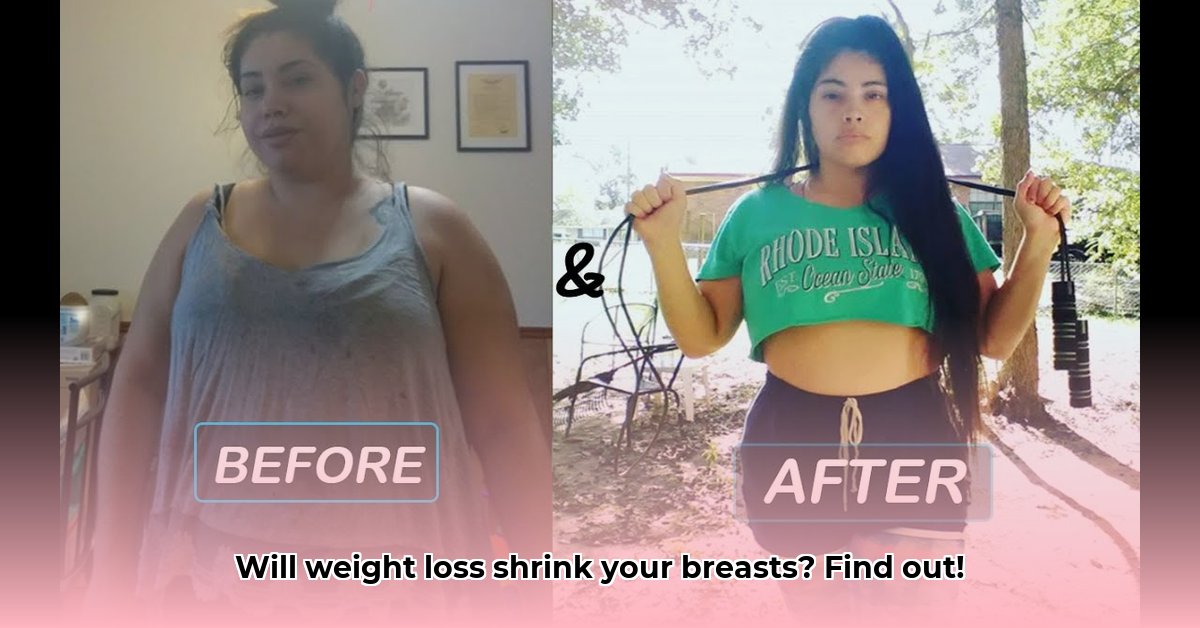
Can Breast Size Be Reduced by Weight Loss?
Many women undergoing weight loss wonder about the impact on their breast size. The answer isn't simple, as it depends on several interconnected factors. While weight loss can indeed reduce breast size, the extent of the change varies significantly from person to person. For more before & after examples, see this page.
Understanding Breast Composition
Breasts are primarily composed of fatty tissue and glandular tissue. Fatty tissue contributes most to breast size and shape, while glandular tissue produces milk during breastfeeding. Weight loss primarily targets fat, so significant weight loss can lead to smaller breasts. However, the glandular tissue generally remains relatively unchanged. This explains why the degree of breast size reduction varies considerably.
How Weight Loss Affects Breast Size
Imagine your breasts as balloons partly filled with water. The water represents the fatty tissue. Weight loss is like draining some of that water, making the balloon smaller. The balloon itself (the glandular tissue) remains largely the same. Therefore, losing significant body fat can result in smaller breasts, but the degree of reduction is highly individual.
Key Factors Influencing Breast Size Change
Several factors determine how much your breast size changes with weight loss:
Initial Body Fat Percentage: Higher initial body fat percentages often correlate with more noticeable breast size reduction after weight loss. This is because there is more fat to be lost.
Genetics: Genetic predisposition significantly influences fat distribution, including where fat is stored in the breasts. This affects both your natural breast size and how it changes during weight loss.
Age: Aging leads to decreased skin elasticity. This can affect how your breasts look after weight loss, potentially making changes more noticeable (either positive or negative).
Hormonal Changes: Hormonal fluctuations, irrespective of weight change, impact breast size. These fluctuations are particularly significant during different life stages.
Rate of Weight Loss: Rapid weight loss can sometimes result in more dramatic skin changes, potentially impacting breast appearance negatively. A gradual approach is generally gentler on the skin.
Individual Results: A Wide Range of Outcomes
The impact of weight loss on breast size is highly individual. Some women experience a significant reduction in cup size, while others see minimal change. Some might even observe a slight increase if muscle growth in the chest area outweighs fat loss. There's no guaranteed outcome; it depends on your unique body composition and response to weight loss.
Realistic Expectations: Focus on Overall Health
It's crucial to avoid fixating solely on breast size changes during weight loss. Prioritize overall health and well-being. A healthy lifestyle—including nutritious eating and regular exercise—is paramount for a happy and fulfilling life, regardless of breast size.
Professional Guidance: Seeking Expert Advice
If you have concerns about how weight loss might affect your breasts, consult your doctor or a healthcare professional. They can offer personalized advice, address any questions, help set realistic goals, and manage your expectations effectively. This approach ensures a safe and healthy weight loss journey.
How to Maintain Breast Firmness During Weight Loss
Three Pivotal Points:
- Gradual weight loss minimizes the impact on skin elasticity and breast appearance.
- Targeted exercise can help maintain muscle tone and support breast tissue.
- Proper bra support is crucial throughout the weight loss process.
Understanding Breast Tissue and Weight Changes
Remember that breast size relies heavily on the amount of fatty tissue. Weight loss involves losing fat, which naturally reduces breast size. However, the extent of this change depends greatly on individual factors.
Factors Affecting Breast Size During Weight Loss (Continued)
Genetics: Your genetic makeup significantly influences fat distribution in your body, including breast tissue.
Initial Breast Size: Women with larger breasts may experience more noticeable changes in size compared to those with smaller breasts.
Rate of Weight Loss: Rapid weight loss can lead to sagging due to decreased skin elasticity. Slow and steady weight loss is more beneficial.
Age: Skin elasticity diminishes with age, increasing the likelihood of sagging after substantial weight loss.
Hormonal Fluctuations: Estrogen levels are crucial for breast tissue health. Weight loss might affect hormone levels, further influencing breast size and shape. This is why a balanced approach considering nutrition and overall health is essential.
Strategies for Minimizing Breast Changes During Weight Loss
Gradual Weight Loss: Aim for a slow and steady weight loss to allow your skin to adapt gradually, minimizing sagging.
Targeted Exercises: Chest-strengthening exercises, such as push-ups and chest presses, help maintain muscle tone and support breast tissue. They aim to enhance firmness and overall appearance.
Supportive Bras: Wearing a well-fitting, supportive bra throughout the day, especially during exercise, provides crucial support and helps prevent sagging.
Nutrition: A balanced diet with adequate protein and healthy fats is essential for maintaining skin and tissue health. Sufficient hydration is also key to skin elasticity and overall health.
Skincare: Topical creams or serums might help improve skin elasticity and firmness (although the effectiveness of such products varies widely). Your healthcare provider can help you select appropriate products.
Professional Consultation: If you have major concerns, consulting a healthcare professional or a plastic surgeon can provide personalized advice and explore options such as surgical procedures if appropriate.
Post-Weight Loss Options
For significant changes in breast shape or size after weight loss, consider these options:
Non-Surgical Methods: Supportive bras and skincare products are non-surgical choices (although evidence supporting their effectiveness in this specific context is variable).
Surgical Options: Breast lifts or augmentations can be considered; however, these are decisions needing thorough consultation with a plastic surgeon to assess suitability and discuss risks and potential benefits.